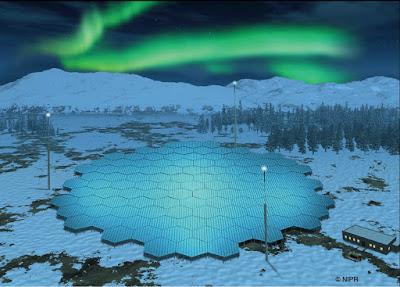Research Councils Team Up to Build World’s Most Advanced Space Weather Radar

While everyone was looking up last month at the solar eclipse, a team of scientists were looking forward by breaking ground on the most advanced space weather radar in the world.
This summer, construction began in Ramfjordmoen, Norway on the EISCAT_3D radar system to test new hardware. EISCAT_3D, the next generation of the European Incoherent Scatter Scientific Association (EISCAT), will be the most advanced space weather radar in the world when construction is completed in 2021. The project will spread £63 million ($80 million) of funding from research councils of Norway, Sweden, Finland, Japan, China and the United Kingdom across three future construction sites: Skibotn, Norway, Kiruna, Sweden, and Kaaresuvanto, Finland.
"EISCAT_3D is an exciting new scientific instrument that will help us look into phenomena such as the aurora borealis in three dimensions, with speeds down to a small fraction of a second, and with resolution down to 100 meters at 100 kilometers and more above the earth," Dr. Craig Heinselman, Director of the EISCAT Scientific Association, told High North News.
Advancement in Radar to Study Solar Storms
The current EISCAT system, which consists of several radar stations in the northern hemisphere, provides a single beam of radar, limiting researchers to only examine a small portion of the sky at a given time. The new system will be able to scan the entire 3D volume of the upper atmosphere in unprecedented detail.
"EISCAT_3D uses a version of active phased-array technology to allow very rapid steering of the radar beams," explains Dr. Heinselman. "What this means is that we start with a large number (approximately 10000) of very simple antennas and combine them electronically to form what is equivalent to a very large antenna with a narrow beam."
"The difference between this and standard dish antennas is that this antenna can be pointed toward different parts of the sky extremely rapidly; instead of steering the antenna by moving tons of steel, the steering is done electronically." Dr. Heinselman also noted that the system will digitize the signal at each small antenna, allowing for multiple receive beams simultaneously.
The new system will be used to probe the upper atmosphere and near-Earth space to better understand the effects of space weather. That weather is primarily driven by driven by solar storms – a variety of eruptions of mass and energy from the sun’s surface. Solar storms hold the immense potential to flow along the Sun’s magnetic field and collide with Earth’s own magnetic field and trapped radiation belts; but, one of the biggest challenges in studying space weather science is improving our understanding of how Earth’s magnetic field responds to these flows of solar energy.
Studying the Forces Behind the Northern Lights
EISCAT_3D will give scientists the means to analyze these collisions in detail. "A key area of research is the ionosphere and its related space weather effects," Dr. Heinselman says. "The location for EISCAT_3D was chosen, in part, because it lies under the auroral oval and will be able to probe this important part of Earth's upper atmosphere."
While the spectacular aurora displays are important for residents and visitors of the Arctic alike, the collisions that create the northern lights are what excite Dr. Heinselman most about the project." Scientifically, an extremely exciting topic is the electrodynamics of auroral arcs. We will, for the first time, be able to probe the plasma side of auroral phenomena at time and spacial scales that we know are important from optical and other measurements."
Beyond the aurora displays, solar eruptions can impact power systems and electric devices. As Dr. Heinselman and the international partnership of scientists work to build EISCAT_3D across the Scandinavian Arctic, the advancement in space weather radar will help to reduce the uncertainty. Over the next five years the team will be doing and supporting outreach efforts as part of the project to share their findings with the public.

